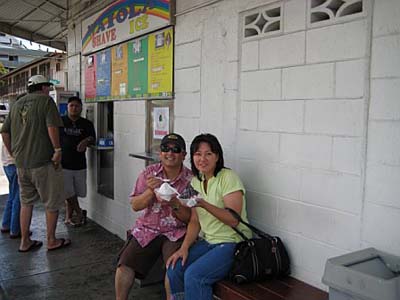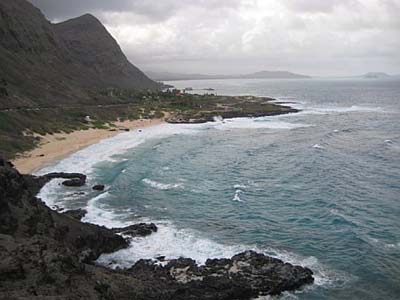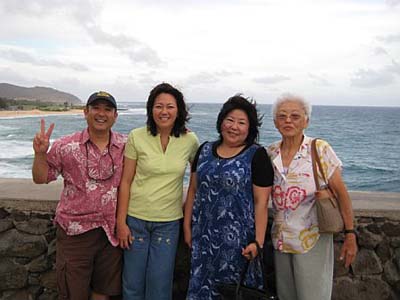21 Sep Hawaiian Eye – Pt. 4 (Family tour)
 We had heavenly shave ice at the Waiola corner grocery, which was just a block from where my grandfather had his home and business. The spot now has a high-rise apartment or condo on it, and the location of the Honolulu Stadium next door is now a park. We had heavenly shave ice at the Waiola corner grocery, which was just a block from where my grandfather had his home and business. The spot now has a high-rise apartment or condo on it, and the location of the Honolulu Stadium next door is now a park. |
Monday, Sept. 17
This day was one of discovery about my family. It began with my cousin Aileen Moriwake guiding us to the apartment of my Aunt Mary Asakawa and my cousin Keith, who’s probably around my age.
We met Aileen at the Ala Moana Center, a shopping mall in downtown near the Waikiki district, and she led us across a street and down a block to a building tucked away behind a high rise and next to some dilapidated old shacks. Honolulu is full of these juxtapositions of new and fancy with old and rundown. Ramshackle single family homes and low-lying old apartment buildings can often be found shoe-horned into tight spaces between modern developments. I figure this is a side-effect of rapid growth and economic boom times.
We had tried calling my Auntie Mary’s phone number but got a “no longer in service” message. Some of the Hanzawa and Sakuma cousins had visited with her to get her to attend the reunion but she declined. Aileen had spoken to her from time to time too. I know the Asakawas are a private family – we didn’t even know that my Uncle Alex had died some years back. The last time I spoke to Uncle Alex, my dad’s brother, was when I tracked him down to tell him my father had died, back in 1992.
Aileen decided we should just go to the apartment and see if we could visit with my Aunt Mary. I pressed the buzzer for the apartment, and a man’s voice answered. It was my cousin Keith.
Unfortunately, my Aunt Mary was out and Keith was about to head to work (for the Transportation Safety Administration), so we had just a brief conversation over the building’s intercom. I got their phone number – we had one digit wrong, which was why we got the disconnected message – and I’ll call sometime after I get back to Colorado.
From the apartment, we returned to the mall and got into Aileen’s car. She took us to an older residential area west of downtown, at the corner of Waiola Street and Makahiki Way and pointed to a high-rise apartment building. It’s where my grandfather and his family used to live, and where his construction business was based. It’s where the old picture I have, with the sign announcing “K. Asakawa Construction,” and all the Asakawa kids lined up in front of the building, was taken.
I tried to get my bearings, and couldn’t really. I don’t know Honolulu well enough. I asked later if the house was close to the beach, and it wasn’t that close. Still, back in the day when people still walked everywhere, it was close enough for the kids to walk to the beach. It was just a haul.
A stone’s throw away she took us to Mo’Ili’Ili Park, which for decades used to be the site of the old Honolulu Stadium. It was built in 1929 and torn down in 1987, so I figure my dad and his brothers and sister used to go see high school or amateur baseball games there.
Aileen then took us down a block on Waiola to a corner grocery store run by a Chinese family, where we got some shave ice at a walk-up window on the side of the shop. A steady stream of people came by for the shave ice. And for good reason – the Waiola Shave Ice shop was wonderful.
Shave Ice is a Hawaiian phenomenon (it’s not “shaved” ice, by the way, it’s “shave” ice), where ice isn’t crushed down to crunchy bits like with a typical mainland snow-cone. Shave Ice is ice shaved down to such a fine texture that it’s like putting snowflakes on your tongue. The ice is then put in a bowl or cone and enhanced with flavored syrups (the more exotic the better) and other extras.
The Waiola Shave Ice was piled high, and Erin had hers topped with green tea syrups, azuki sweet red beans and tiny mochi, or sticky rice, balls. I had mine with a serving of custard (the Japanese equivalent of Mexican flan) buried with ice and topped off with haupia coconut syrup. Both were heavenly. We ended up having great conversations with the other customers, including a couple of Hawaii-born old-timers who swore this was the best shave ice on the island, and a couple who had recently moved from Denver and considered Waiola their shave ice mecca.
With dessert under our belts, we headed for lunch.
 One of the zillions of postcard views of beaches along the Oahu shore. One of the zillions of postcard views of beaches along the Oahu shore. |
Aileen steered us back to the Ala Moana Center, to a relatively new restaurant, Tsukiji. Tsukiji is the world-famous fish market in Tokyo, and the restaurant here specialized in fish and even had a fish market in the front, but apparently shoppers weren’t really interested in picking up fresh fish with their Gap purchases; the fish market was dark and the restaurant focused on serving food. The food was buffet-style, with a wide array of pretty authentic Japanese cuisine available, from sushi at one end to ramen and udon at the other. In between there local dishes like kahlua turkey (a nice break from the ubiquitous pork) and kahlua fried rice, and some Korean specialties like kim chee and calbi short ribs.
After lunch, Aileen led us to a mini-tour of the Hanzawa family spots in the city, from the corner next to a river where her grandparents had their house (now occupied by a fancy modern medical office building) and a nearby wooden apartment building built by her grandfather’s family where family members have lived over the years (her grandfather Hanzawa was, like my grandfather Asakawa, a contractor). She also took us by the family cemetery, a crowded graveyard jammed with tall memorial structures, Japanese-style, like a city of the dead.
After the tour, she took us back to the shopping mall to meet up with my cousin Marian and Auntie Harriet (who, as Erin points out, is technically also my cousin, even though she’s an aunt to Aileen and Marian and the others – this family tree stuff is so complicated for me). Aileen handed us off, and Harriet drove in her giant American car, a big change from Aileen’s tiny, quiet Prius, to show us some of the sites of eastern Oahu. We stopped and took pictures at Sandy Beach and Blow Hole (a spot where the waves force water to shoot up like a whale’s spout) and had a lot of laughter and conversation for a couple of hours.
At dinner time, Auntie Harriet drove us back past the Hawaii Kai area where she lives (and where Aileen, and our friend Richela lives) to a strip mall that had a Chinese restaurant, Duck Yun, as well as a Chuck E. Cheese in the corner. As we climbed out of the car, we coincidentally saw our cousin Lynn and her husband Bobby, who are from New York City. They were heading for the Chuck E. Cheese for raucous evening celebrating the birthday of Lynn’s nephew, my Uncle Roy’s (actually cousin Roy) grandson. Phew … more tangled branches.
 We stopped at several lookout points and posed with cousin Marian and Auntie Harriet. We stopped at several lookout points and posed with cousin Marian and Auntie Harriet. |
Dinner was great once again (Hawaii definitely ranks as an orgasmic food experience). We let Marian’s brother Ron order from the menu, Along with Harriet, Marian and Ron’s parents, Auntie Mae (a Hanzawa, Harriet’s sister) and Hiroshi, were there. We had a Chinese feast while we laughed and talked long after the restaurant closed.
When Erin asked my Aunties about their memories of my grandmother, the conversation got even more interesting. They have some vivid memories of my grandmother, and of my dad and his brothers and sisters.
One thing I realized is that all these years since my father’s death, I’ve been focused on my father’s experience living in Japan during World War II and learning about my grandfather. Because I was told (or assumed) that my grandmother was a picture bride sent to marry my grandfather in Hawaii, I never thought about studying her side of the family.
But as the stories unfolded about Tomeno Hanzawa, my grandmother, who was not a picture bride at all but a woman who married my grandfather out of love and bore eight children, I began to realize that the really important story that needs to be told is her tale, not my father’s or grandfather’s.
In a way, fate and circumstance and possibly even my grandfather, and my father and his family with their silence, conspired to make Tomeno invisible, and erase her existence from the collective family memory.
My mission now is to research her story, and pay tribute to my grandmother.



